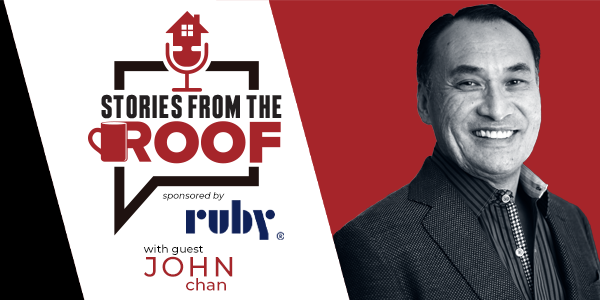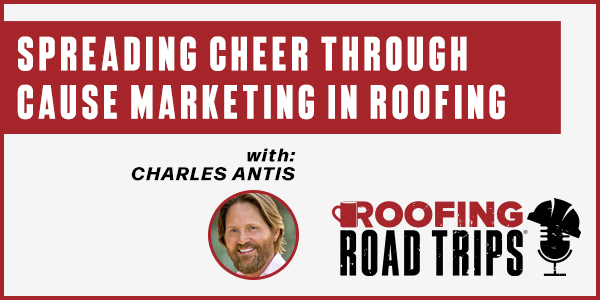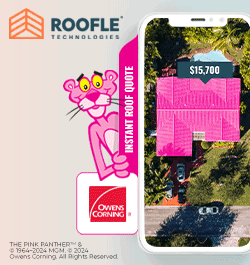John Chan - PODCAST TRANSCRIPT
June 11, 2024 at 12:00 p.m.Editor's note: The following is the transcript of a live interview with John Chan from The Durable Slate Company. You can read the interview below or listen to the podcast.
Intro: Welcome to Stories From the Roof, the podcast that brings you tales from the most unexpected vantage point, rooftops. I'm your host, Megan Ellsworth, and on this show we'll ascend to the top and explore the world through the eyes of those who live and work above. Join us on this unique journey as we uncover the stories, perspectives and histories of roofing contractors. Let's begin our ascent onto the roof.
Megan Ellsworth: Hi, everyone. My name is Megan Ellsworth here at rooferscoffeeshop.com and we are on Stories From the Roof from RoofersCoffeeShop. I'm so excited to have John Chan with us here from The Durable Slate Company. Hi, John. How are you?
John Chan: Great. How are you doing today?
Megan Ellsworth: I'm doing fabulous. Excited to hear more about your story and your wisdom and insights in roofing. Let's just dive in and have you introduce yourself.
John Chan: Okay. Well, my name's John Chan. I'm one of the principals of The Durable Slate Company. We're a historic roofing company, so we work with natural slate, clay tile and sheet metal, most of the sheet metal being copper. We've been in business for, gosh, 38 years now, and we've done work all over the country and even some abroad.
Megan Ellsworth: That's so cool that you guys do work abroad. I think that's so fascinating. I know last time you were on the podcast we were talking about all the different quarries you've been to and slate things, so that's really cool. Let's go back to the very beginning. How did you get into roofing?
John Chan: Well, it was actually a summer job for me. I lived in Columbus, Ohio but I went to school at UCLA, so when I came back for the summers I was looking for a job and somebody told me about this construction job. I was saying, "Oh, that sounds great. I'll be working outside, getting a workout, getting a tan. It was good pay." So that's how I started. I was just cleaning up trash, cutting slate, carrying slate up and down a roof, and then as the summers got to be more and more... A little bit more and more learning on the job, after several summers I started tearing roofs off and cutting up sheet metal for the guys. Yeah, it was a very low first rung of the ladder start.
Megan Ellsworth: That's awesome. I think that is a great start, and it's cool that you've always been in slate from day one.
John Chan: Yeah.
Megan Ellsworth: That's awesome.
John Chan: Yeah. Yeah. It's really interesting. After college, I came back and started full-time, and at that time all we did were slate repairs because there was nobody really doing it, and then we started to get into the other historic roofs. It was actually kind of funny. One of our customers who had a lot of rental property down on campus, all of them were slate so we always fixed her leaks. She always tried to get us to work on a clay tile roof and we said, "Well, we don't really do that." That's how we got into tile because she said, "Hey, I've had 13 different people out here and nobody can fix my leak. I need somebody to fix it." That's how we got into clay tile and then eventually into sheet metal.
Megan Ellsworth: Wow. Oh my gosh. That's really interesting. I kind of love that it came from necessity almost.
John Chan: It was really interesting because I didn't know much about clay tile roofs, and when I first saw the pictures that she sent us there weren't any tiles missing so I was thinking, "I wonder what's going on?" A friend of mine had another friend, his name was Ken McGhee, and at one time he'd worked for Ludowici for a very long time and in fact his dad was the president of Ludowici. Ken started telling me all about tile and he was telling me about all the nuances of the different tiles and why they leak and all the different aspects of clay tile, and I was like, "This is really fascinating." As I started finding out that as I talked to more and more people, I knew more about clay tile than most just from Ken so that's kind of how we got into tile roofing.
Megan Ellsworth: Wow. Oh, that's awesome. That literally ties right into our next question, which is who taught you about roofing? Maybe tell us a little bit more about Ken and if there's anyone else.
John Chan: Sure. Yeah. Well, the guy who started the company, Steve May, he's the guy that taught me about slate roofing originally, told me about layout and headlap and when you tear off so much you also learn how roofs were put together and you also get to see what failed. Then, like I said, I learned quite a bit from Ken, and then from Ken I realized that salvage tile had a value so we also started salvaging clay tile roofs. In doing that process, I also saw why clay tile roofs failed. I saw the underlayments fail, I saw the flashings fail and I saw what lasted and what didn't. That was a really, really great introduction to roofing. It was tearing off all those old slate and tile roofs.
John Chan: A lot of them also had sheet metal. They had terne or copper flat-lock roofs or standing seam roofs and bay roofs, and you got to see all the different reasons why these old roofs failed and how long they took to fail. It was such an interesting process. So yeah, from Steve I learned slate originally and from Ken I originally learned the clay tile. I would say on the sheet metal side, we started doing a bunch of sheet metal and we would sub it out to this company called Herman Jeffries Sheet Metal. After a while, Herman just came to us and said, "Hey, I'm just doing all these jobs for you." He goes, "I've got an idea." He goes, "Why don't I just come work for you? I'll bring all my guys; you can buy my equipment and that way I don't have to deal with all the headache of running a company." So we did. We bought all of Herman's equipment and Herman and his son, Ray and Jimmy and Kevin, they all came to work for us. It's actually kind of funny. That was back in 1992 and-
Megan Ellsworth: Wow.
John Chan: ... his son... Yeah, his son Ray and one of his helpers, Jimmy, they still work for us today.
Megan Ellsworth: No way.
John Chan: Yeah. Yeah. So all the way back from '92 when Herman first came to work for us. Yeah, we still have a couple of those guys.
Megan Ellsworth: Wow. Oh my gosh. That's cool. I love that legacy and having people there for so long. That's like 30 years. Amazing.
John Chan: Yeah. Yeah. Yeah, that's how we first got into sheet metal, and then I learned a lot more about sheet metal back in '96. There was a guy named AG Zalal, and AG had a roofing company in Raleigh called Afghan Roofing and he also imported equipment from Germany and Europe. We decided to pay him a visit and then also go over to the... It was called the Dach und Wand back then. It was a roof and wall show in Germany, and we went to the... Yeah, we went to the Bocker factory and we actually purchased a Bocker machine, which is a... Trying to describe the machine. It's kind of like a laddervator on steroids. Our Bocker machine will hoist material up or down. I'm trying to think how tall it is. It's 137 feet, so it'll take 660 pounds I believe it is up or down that distance, and also has a knuckle on it so you can angle it to the pitch of your roof. You can haul your slate up or your plywood or your underlayment, and then you can also haul all the slate down that you're tearing off.
John Chan: It was a fabulous machine, and AG introduced me to the folding techniques that they use over in Europe that... They're not very common over here. He's kind of almost like the grandfather of European roofing here in the US to a certain degree. I bought a lot of those different types of snips and bending tools that he was the only one that carried them back then. It was 1996.
Megan Ellsworth: Wow.
John Chan: Yeah. Then his brother also taught me in his shop how to make folds around the chimney and whatnot. So yeah, I picked up a lot of different things from different people through the years.
Megan Ellsworth: My favorite thing about you kind of telling your story just then was that you had a smile on your face the whole time, and just that's what I love about this podcast and sharing people's stories and kind of looking back on this great career that you've had and will continue to have, so thanks for sharing. I thought that's great.
John Chan: Oh, you're welcome. It's always great to learn all the different things from different people because so many different people have so many different backgrounds and things that they've learned through the years, and it's fabulous just getting all that knowledge.
Megan Ellsworth: Yeah, absolutely. Absolutely. Kind of going off of wisdom and knowledge that you gather, what is one of the most valuable lessons you've learned about roofing or business throughout your career?
John Chan: Well, that's an interesting thing. I think it was basically learning how to relate to people. Early in my career, I was trained up by my brother who was running the company at the time, and I saw how he would shift gears because we worked in a lot of different neighborhoods. Some of the neighborhoods were very, very affluent, and some of these neighborhoods were... They were really, really old, not so great neighborhoods. They were great way back in the day in 1910 or something like that, but a lot of the houses were dilapidated, the homeowners were barely hanging on to try and fix their slate roofs and sometimes we'd be dealing with architects or, in my case, a lot of roofers where we're tearing off these old roofs. What I really learned was how to deal with everybody and treat them with respect and be able to communicate with people and really just get to understand people so that you can achieve your goals of whether it's sales or recruiting or whatever it is, that you treat people with great respect and being able to handle things with communication.
Megan Ellsworth: Absolutely. Communication is truly key, paramount, step number one, and also respect. I couldn't agree more with what you just said. If you were to go back to the start, to the beginning of your career, you're tearing off slate roofs, what would you do differently, if anything?
John Chan: Gosh, probably one of the things I would've done was when I went over to Germany in '96 and got a taste of the European folds and some European techniques and also green roofing, we probably would've implemented some of that right away because it was a tough thing. When I came back and I was showing all of our sheet metal guys all these really cool ways to flash around the chimney and to do valleys differently, it really upset the apple cart and nobody really wanted to do it. I probably should have just insisted on them at least learning because I'm not one of those guys that say, "We have to do it a certain way."
John Chan: But there's a lot of different ways to do flashings or whatever, but there's always a best way. Not everything has to be done in a European fold and not everything has to be soldered, but there are certain times where you want to fold and there are certain times where you want to solder. I think that sometimes Europeans get so proud of the folding they want to fold with everything, and then the Americans, they look at the folding and it's like, "Oh, that's crazy. Just solder it." But there's certain times where you have to do one method or the other. I can think of an example right now. We just did the clocks around the Logan County Courthouse in Lincoln, Illinois. Lincoln is named after Abe Lincoln because he actually used to practice law there, not in that building, that building's a little bit newer, but he practiced law in the old courthouse. These clocks are about... Yeah, they're about 13 feet, that's just a guess, wide. The copper roofs there consistently failed, and the reason is when you solder completely the round clock like that, that's a huge solder joint, you know?
Megan Ellsworth: Yeah.
John Chan: Yeah, the sun hits it, it expands, it goes beyond the horizon and it shrinks and it comes back out and it's beaming on one side so one side's expanding greatly and the other side is still cool because it's wintertime and it's not expanded and all that shifting tears those solder joints apart. What we did was we put in pleated valleys. What pleated valleys are is if you think of kind of like an accordion, you take your valley and you just fold it and you fold it in a way to wrap it around the clock and then you just lock that valley onto your standing seam panels and when it gets hot it acts like an accordion and just expands and then when it gets cold it shrinks and it doesn't break any of the solder joints because nothing's soldered, right?
Megan Ellsworth: Yeah.
John Chan: We have that same thing going on where we're just starting a dome in Baltimore at Davidge Hall. This building is the oldest medical instructional building in the US that's still standing.
Megan Ellsworth: Wow.
John Chan: Yeah. It's for the University of Maryland. It was originally copper. They've replaced it with copper a few times, and then I want to say it was in the '70s they decided to replace it with a wood roof because that copper dome kept leaking, they couldn't stop the leaks from occurring and then it got re-roofed again in the '90s again with wood because they were afraid of the leaks. Finally an architect was saying, "Well, it was copper for well over 100 years. Why can't we put it back on in copper?"
John Chan: In the consulting process, we came up with ways that it can be done. The thing of it is that any large copper dome like that, the copper has got to be able to move so you've got to put something like copper shingles on it or copper standing seam panels where each of the fixed points can stay independent of the other fixed points. In the Lincoln job, you had those four huge clocks. Well, those clocks, they're not going to move so you've got to have eight fixed points within that working independently so that the copper can move when it gets hot and cold. In Davidge Hall, we're going to do that. We're going to use pinch seams on certain parts of it to allow for that dome to be able to move. We're doing another one in Louisiana right now. It's another dome that has these copper clocks on them, and that's a huge problem when these big copper domes or steeples or whatnot, they get hot and cold and it just tears them apart.
John Chan: I think going back to... Sorry, going back to your original question of what I would've done differently is, number one, is I would've insisted that our sheet metal guys learn all of those techniques way back then and so that we could have an option of, "We want to solder here, we want to fold here." Because some places you definitely want to solder, you know?
Megan Ellsworth: Yeah.
John Chan: We did a big copper roof in Georgetown. In fact, that building is supposedly where George Washington and L'Enfant planned out the entire city.
Megan Ellsworth: Oh, whoa.
John Chan: Yeah, it's a very historic building, and it's got a big low-pitched copper roof on it. What's changed over the years is that it's become a restaurant, so they put all these air handlers and HVAC systems on top of the roof that weren't there back in the 1700s. All of those points are fixed, so what we did was we put a series of standing seam panels and pinch seams and then where it gets very low-pitched, we put in soldered panels kind of like a bathtub, but all those bathtubs, they're all soldered together but all the standing seam is locked into those so that the roof can float. But the places that receive so much water that they fill up, they'll fill up and they'll be watertight because they're all soldered together. There's things that you have to do like that, and that's one of the things that we would've done back then. Then also the green roofs. I find those fascinating, you know?
Megan Ellsworth: Yeah.
John Chan: They've been doing those in Europe. Yeah, they've been doing them for a really long time, and we talked about doing it, but it was just kind of a thing of, "We don't really do that type of flat roofing." But we would've been really on the cutting edge doing it in 1996. Those are probably the two things that I would've done differently, but, to be honest, I'm not sure exactly how we would've done that because we didn't really have the personnel to do it at that time.
Megan Ellsworth: Yeah. Yeah. Because it's good to be realistic for sure. I think the accordion metaphor you had, that was so interesting. Also I would love more green roofs. I think they're so fascinating, like you said. I wish I had a green roof and a little garden on my house. That'd be so fun.
John Chan: Yeah.
Megan Ellsworth: But yeah, we definitely have different building techniques here than over in Europe where there are more green roofs. Maybe one day we'll get more around.
John Chan: Yeah. I think it's inevitable because they're so good from so many reasons. When you get a torrential downpour, for instance, if you have a bunch of green roofs you won't get flooding because the rain gets absorbed in those roofs and it's a slow siphoning down or whatever you want to call it of all of that water, so you don't get that inundation of water. Another thing is with all of the extra green, it helps the environment. There's a lot of great reasons for a green roof. I was just over in Edinburgh... Gosh, when was that? A month or two ago. In our hotel, we were staying on I think the fifth floor and you go out and there's this courtyard and there's all these trees and grass and bushes and you would think that-
Megan Ellsworth: Really?
John Chan: ... you're outside in a park, but it's just the center courtyard and you're on top of a building right downtown Edinburgh.
Megan Ellsworth: Wow.
John Chan: Yeah. Yeah.
Megan Ellsworth: That's super cool, and so nice too to be able to have that outside your hotel room. That's so nice.
John Chan: Exactly. Yeah. Yeah.
Megan Ellsworth: Next question, what is the best thing you've ever done for your business or career?
John Chan: Gosh. Ooh, that's a hard one.
Megan Ellsworth: Toughie.
John Chan: Best thing. I would say the implementation of Hubbard Management Technology because it's really allowed us to compartmentalize things and organize things so that we function really, really well and it's not so chaotic because if you think about it, we've got... To be honest, I'm not exactly sure on the number, but somewhere around 150 employees. They're all around the country. Gosh, we've got a project going on in Bosnia right now, so they're-
Megan Ellsworth: Oh, wow.
John Chan: Yeah, they're spread out all over. I mean, we just started a job in Helena, Montana. We've got stuff going on all over, and basically it's given us the organizational skills to have all these different things going on and keep our wits about us. I think that that's fabulous.
Megan Ellsworth: Yeah. I do too. I mean, to have one job in Helena, another in Bosnia, that really goes to show the management of all the different moving parts that you have. Yeah. That's great. Oh my gosh. In one word, describe the most important trait in a co-worker or an employee.
John Chan: It would probably be willingness or maybe desire, you know?
Megan Ellsworth: Mm-hmm.
John Chan: Because as long as they've got that, you can train them on everything else. You can train them on how to repair a slate, you can train them on how to fold up a pleated valley or you can train them on how to lay out a tile roof. That's the funny thing. It's like we have guys that are really good at certain things and maybe not so good at other things, but if they've got that willingness to learn, we've really implemented a lot of good training techniques to teach people even if it takes them a long time. At the end of it, they'll get it, so that willingness and desire to succeed really supersedes all because you can really mold a person and give them all the knowledge that they need to succeed if they've got that. If they're apathetic towards it, obviously they're not going to get very far. A lot of people might say intelligence or whatever, but if you've just got that willingness and desire, we can get the training right to get the person going.
Megan Ellsworth: Yes. I completely agree with that.
Megan Ellsworth: Much more than a virtual assistant answering calls, scheduling appointments, customer intake, payment collection and more, Ruby does it all so busy contractors don't have to. As a member of the RoofersCoffeeShop community, you can use code RCS100 to save $100 on your first three months with Ruby. Take $100 off your first three months with Ruby by using coupon code RCS100.
Megan Ellsworth: Who is the best boss you've ever had and what did they teach you?
John Chan: Well, it's kind of a funny thing. I really only had one boss. It was my brother. When I came in to work at Durable, he was running the company and basically I just learned one thing at a time and did different posts. Like I said, probably the best thing that he taught me was communication, like I said. Being able to communicate and handle people, make sure that things go right, that's so invaluable. Also, it has to do with communication also, but being able to get a person excited about what you're talking about. Whether it's recruiting somebody to come to your company or selling a customer or selling your crew on doing the right thing and training and all of that, that's all a part of communication. It's like getting people excited was something that he was always really good at.
John Chan: I remember going back when I was brought into the company, I'd just finished college at UCLA, economics degree. I had all kinds of interesting job offers, but instead I went back to Columbus, Ohio and started off basically as a laborer in the company earning very little money, but the picture of a future that he painted for me was very bright. When I looked at it, I was just like, "Yah, that could be done. That could be done." That's one of the traits that he really has, he's really good at and it's by communicating a rosy future that you would have to put your two feet in to make sure that it happened that way but being able to convey that. I watched him convey that to customers, convey that to prospective employees.
John Chan: Gosh, in the start he was so good at getting top-notch talent into our company. As I observed that, I was just like, "Wow. That's really something." It's just an offshoot sort of, say, of communication, but that's something that I really picked up from him and really saw how to do that. It's really by really being upfront, understanding people, treating them with respect and really granting them all of their space and what they want to say and really getting their viewpoint on something and then kind of putting in your two cents on how the two of you can come to a good solution about something. It's really, really cool what I picked up from him, and that's probably the biggest thing.
Megan Ellsworth: That is so special. I work with my big brother too, and so I know the pain and the love. That's really special, I think, a special experience. To get to learn from a sibling also outside of being siblings is really cool too.
John Chan: Right.
Megan Ellsworth: We only have a couple of questions left. You've been slaying these questions. What makes you smile when you think about your job?
John Chan: Well, it's just really exciting and rewarding. What we do is much, much different than most other roofing companies. I've been approached by... Because we're so specialized, I've been approached by various people to do other things like commercial flat roofing, storm work, "Oh, there's so much money in this. If I show you how to do this..." All of that stuff doesn't interest me at all, you know?
Megan Ellsworth: Mm-hmm.
John Chan: That's the funniest thing. It's like I don't doubt or discount that you could make more money or whatever, but it's the excitement of restoring these unbelievably iconic buildings from all over the US. I mean, we've worked on a number of different presidents' homes or their places. We did Roosevelt's ranch out in North Dakota, Lincoln's birthplace in Kentucky, a number of the presidential homes in Ohio and Indiana, a number of embassies and very historic properties and government buildings in Washington, DC, prehistoric... I'm sorry, not prehistoric, pre-revolutionary homes in Virginia and South Carolina, New Orleans. I mean, we've worked on such iconic buildings and restored the beauty back to so many of them, and also just that we've done it all over the place. We've worked in, gosh, I don't know, 35, 38... I don't know the number. Well over 30 states in the US and as well as I said abroad and working on things like the House of Parliament in Trinidad or doing that really cool place in Lima, Peru and just doing all that type of work and also just exploring all those places, you know?
Megan Ellsworth: Mm-hmm.
John Chan: Being able to go to all these different places like Lima, Peru. When we were there, we got to go to Machu Picchu.
Megan Ellsworth: Wow.
John Chan: Yeah. Lima's such an interesting place because I don't think it is anymore, but at one time it had three of the top 10 restaurants in the world.
Megan Ellsworth: Oh wow.
John Chan: The number one restaurant in the world right now is in Lima, Peru. We tried them all. It's just really cool checking out all the different cultures and also just all the different quarries and everything I've visited. I've visited pretty much every single quarry in the United States in New York, Vermont, Pennsylvania, Virginia, even some of the quarries that are defunct like Peach Bottom that they went out of business in the '50s and we still did a thing there, and all the different quarries in Spain, the different Cupa quarries, Matacouta, La Baña, Hebra, all the different quarries there, Del Castillo, and even into Wales, the Welsh quarries, Penrhyn, Cwt y Bugail, and even down the UK down in Cornwall, Delabole, just going to all these different places. Even the tile and metal too. Just a few months ago, we visited VMZINC over there in France and we did the La Escandella factory. They're the largest tile manufacturer in the world. They're in Alicante, Spain.
Megan Ellsworth: Wow.
John Chan: Yeah. Like I said, it's just so exciting to A) restore all these beautiful places, B) visit all these unbelievable places all over the world, and also meet all these different people because we've been to a number of the international shows. One of our copper projects won the IFD or the International Federation for Roofing Contractors Award for the top sheet metal project. That was in Edinburgh.
Megan Ellsworth: Wow.
John Chan: Yeah. Yes. We've met so many great people that are doing fabulous work from all around the world, so it's always been really exciting. I guess that's what keeps the smile on my face and makes things exciting because not only do we get to restore these amazing places, but we get to visit all these fabulous sites from around the world and dabble into their culture and their food and everything else.
Megan Ellsworth: Absolutely. Absolutely. I mean, that is such a highlight. I can only imagine going to all these different places and also seeing the different architecture types and styles of roofs and building structures and all sorts of stuff, so keeps you on your toes and, like you said, keeps a smile there. It's never fading. I love it.
John Chan: Yeah. Some of these places are just incredible. In Istanbul, there's places that were built in 5 or 600 and its 1700 years old and it's still in good shape. It's just fascinating.
Megan Ellsworth: Yeah. No, it's incredible. That's so special. That's something super special about The Durable Slate Company, everything you guys do on our homeland here and then overseas. I think that's so cool. We somehow have got to the last question, this went by so quickly, and that is how long have you been following RoofersCoffeeShop and what's your favorite thing about RCS?
John Chan: RCS has changed a lot since I first found out about... When I first found out about it, I want to say it was back in the early '90s and I just thought of it as a classified ad. What I found in it was places to buy old machinery or somebody was selling old slate or tile, and that's basically what I used it for. I didn't really know exactly what it was other than that.
Megan Ellsworth: Yeah.
John Chan: Then I want to say... Gosh, I can't remember exactly when it was. I met Heidi at an event somewhere, and then you guys started popping up all over the place in social media, at the different events, and I was like, "Wow, this is really cool. I remember these guys way back... It's got to have been like 30 years ago or something." I'm just trying to think what I... Because I purchased things from people. I think most of it was reclaimed slate and tile. I might have even gotten... I was talking about the Bocker machine that we purchased when we went to Germany. I think that's where I also purchased... We have a Paus machine. They're two different companies, but they make very similar equipment. It's a lift that takes material up and down. There's no such maker in the US so you've got to get it from Germany.
John Chan: There was a guy that had one that he used for two projects, and he said, "Hey, I've got no use for this." So he had it on sale, and I was just like, "Wow, that's like half price." I was just like, "Okay." Yeah. I had a friend look at it for me, it was out in LA, and he looked at it and said, "Hey, it looks like it runs. Don't know how much work you'll need." I'm like, "Well, at that price we'll just buy it, send it to the manufacturer, and get it all tuned up." It's been real helpful because... That's a funny thing about that type of machinery. A lot of times you don't use it, it just sits in your yard, but then sometimes you need one plus the other and then you could use a third one. That's where I've used RoofersCoffeeShop in the past.
John Chan: What I think of it now is just I think it's fabulous because you guys get to a lot of the different conventions and get out on social media and people can see what everybody's doing. I invited Heidi to our event for the National Slate Association. The National Slate Association's having a conference the last week of October in Charleston, and I thought it'd be really cool for Heidi to come and speak about RoofersCoffeeShop, so yeah, she's going to do that.
Megan Ellsworth: Yay.
John Chan: It's just really... Yeah, it's really great seeing you guys everywhere, and it helps keep the industry all connected. Yeah. It's fabulous.
Megan Ellsworth: Yeah. I'm so glad to hear. Thank you for your kind words. I'm so happy that we can be this place for community and bringing people together. I'm just so happy to hear that, so thank you for sharing.
John Chan: Yeah, yeah.
Megan Ellsworth: Yay.
John Chan: Yeah. It's been great what you guys do.
Megan Ellsworth: Yay. I'm so glad. Well, John, this has been an absolutely amazing podcast. Thank you so much for sharing your wisdom and your story and just your experience in the roofing industry. You have so much to share, so thank you.
John Chan: You're welcome. It's been great being here.
Megan Ellsworth: Amazing. Hopefully we'll have you on another podcast soon. For everyone out there listening, you can go learn more about The Durable Slate Company on rooferscoffeeshop.com on their directory. You can also find them on askaroofer.com. Make sure you are subscribed and get notified every time Stories From the Roof uploads a new episode, and we'll be seeing you next time on the next Stories From the Roof.
Outro: If you've enjoyed these unique rooftop stories, be sure to hit that subscribe button so you don't miss a single episode. Go to rooferscoffeeshop.com to learn more. Thanks for soaring with us on Stories From the Roof. We'll catch you on the next one.
























Comments
Leave a Reply
Have an account? Login to leave a comment!
Sign In